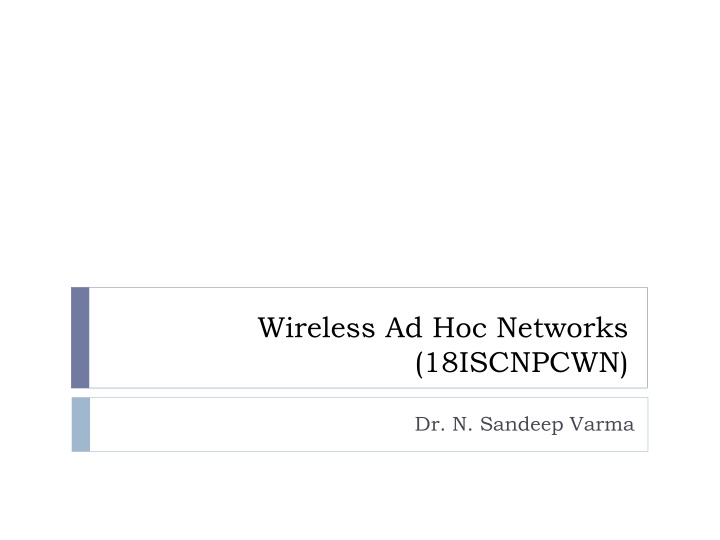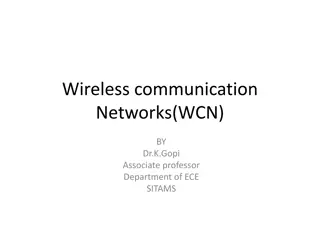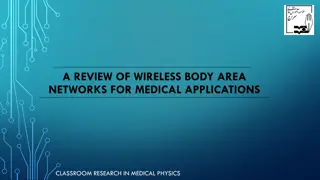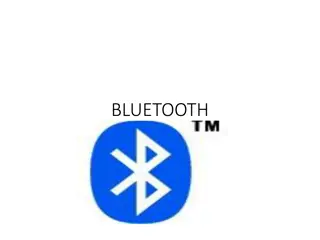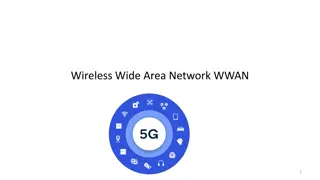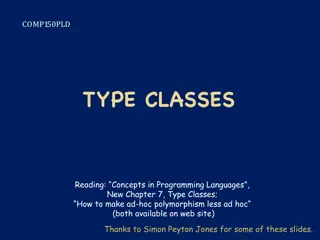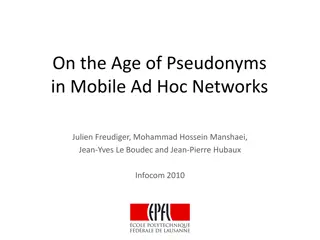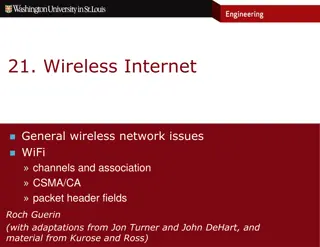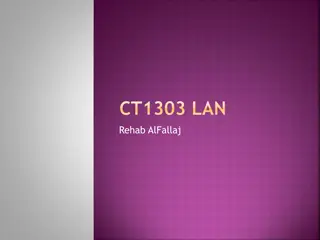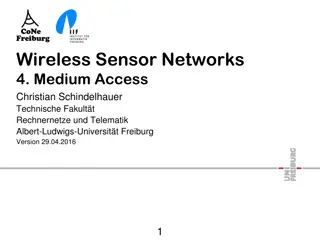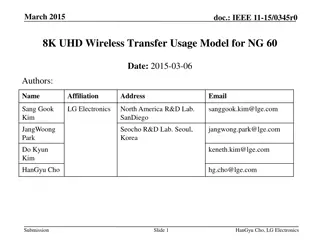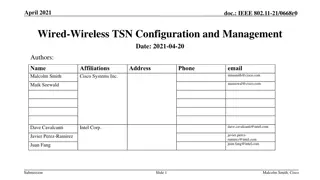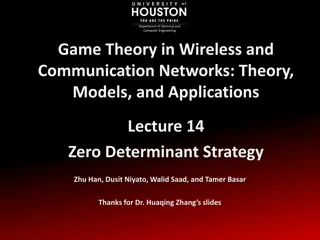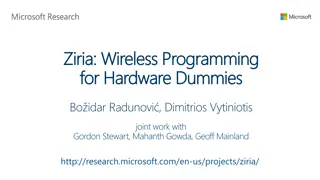Challenges and Solutions in Wireless Ad Hoc Networks
This content delves into the complexities of wireless ad hoc networks, focusing on issues such as medium access control, hidden node problems, and location-dependent carrier sensing. It discusses design challenges, including bandwidth efficiency and quality of service support, as well as practical scenarios illustrating communication challenges between nodes. The content also emphasizes the importance of addressing connectivity issues to ensure efficient communication in ad hoc network environments.
Download Presentation

Please find below an Image/Link to download the presentation.
The content on the website is provided AS IS for your information and personal use only. It may not be sold, licensed, or shared on other websites without obtaining consent from the author.If you encounter any issues during the download, it is possible that the publisher has removed the file from their server.
You are allowed to download the files provided on this website for personal or commercial use, subject to the condition that they are used lawfully. All files are the property of their respective owners.
The content on the website is provided AS IS for your information and personal use only. It may not be sold, licensed, or shared on other websites without obtaining consent from the author.
E N D
Presentation Transcript
Wireless Ad Hoc Networks (18ISCNPCWN) Dr. N. Sandeep Varma
Issues in Ad Hoc Wireless Networks Medium Access Scheme Routing Multicasting Transport Layer Protocol Pricing Scheme Quality of Service Provisioning Self-Organization Security Energy Management Addressing and Service Discovery Scalability Deployment Considerations
Medium Access Control - Wireless Wireless medium makes the MAC design more challenging than the wireline networks. The three important issues are: 1. Half Duplex operation > Either send or receive but not both at a given time 2. Time varying channel 3. Burst channel errors
MAC Protocol Design Issues Bandwidth efficiency Bandwidth must be utilized in efficient manner Minimal Control overhead BW = ratio of BW used for actual data transmission to the total available BW Quality of service support Essential for supporting time-critical traffic sessions hey have resource reservation mechanism that takes into considerations the nature of wireless channel and the mobility of nodes
Location Dependent Carrier Sensing Hidden Nodes Even if the medium is free near the transmitter, it may not be free near the intended receiver Exposed Nodes Even if the medium is busy near the transmitter, it may be free near the intended receiver
Node B can communicate withA and C both. A and C cannot hear each other. When A transmits to B, C cannot detect the transmission using the carrier sense mechanism. C falsely thinks that the channel is idle. If C transmits,collision will occur at node B.
Consider the case that node B is attempting to transmit toA. . Node C can hear the transmission from B. When B senses the channel it finds the channel to be busy However, any transmission by C cannot reach A (not in range), hence does not interfere with any reception atA. In theory C can therefore have a parallel transmission with any node that cannot hear the transmission from B,i.e.out of range of B. But C will not transmit to any node because its an exposed node. Exposed nodes waste bandwidth.
Assume node A and D transmit simultaneously to B. The signal strength received from D is much higher than that from A, and D s transmission can be decoded without errors in presence of transmissions fromA. D has capturedA Capture is unfair because it gives preference to nodes that are closer to the receiver. It may improve protocol performance.
Contention Based Protocols Sender Initiated Protocols: Single Channel - Complete bandwidth utilization Multichannel - divided over multiple channels Receiver Initiated Protocols Synchronous protocol: Global Synchronization difficult Asynchronous protocol: Real time information for effecting reservations:
MACA Protocol (Multiple Access with Collision Avoidance ) Per Node Basis A slotted media access control protocol. Makes an announcement before it sends the data frame to inform other nodes to keep silent. Sender: Request-To-Send (RTS) with the length of the data frame to send Receiver: Clear-To-Send (CTS) with the length of the frame that is about to receive A node that hears RTS should remain silent to avoid conflict with CTS A node that hears CTS should keep silent until the data transmission is complete
MACAW MACAW: (MACA for Wireless) is a revision of MACA. The sender transmits a RTS (Request To Send) frame if no nearby station transmits a RTS. The receiver replies with a CTS (Clear To Send) frame. Neighbors o see CTS, then keep quiet. o see RTS but not CTS, then keep quiet until the CTS is back to the sender. The receiver sends an ACK when receiving an frame. o Neighbors keep silent until see ACK. Collisions o There is no collision detection. o The senders know collision when they don t receive CTS. o They each wait for the exponential back- off time.
Four Major Design Improvements over MACA Observation 1: node not at the sender. This realization makes CSMA protocols unsuitable for Ad Hoc Networks. Relevant Congestion occurs at receiver a. Resolved by RTS-CTS-DATA exchange mechanism of MACA becomes necessary. b. MACAW is further improved by RTS-CTS- DS-DATA-ACK exchange mechanism
Observation 2: Congestion is dependent on the location of the receiver. Sol: Instead of characterizing back-off by a single back-off parameter, separate back-off parameters have been introduced for each flow
Observation 3: Learning about Congestion at various nodes must be a collective process Sol: Copying back-off values from overheard packets has been introduced. Observation 4: Since nodes content effectively for the channel the synchronization information needs to be propagated to the concerned nodes at appropriate times. Sol: Achieved through DS and RRTS packets
Single-channel sender-initiated protocols FAMA: Floor Acquisition Multiple Access Protocols. Channel access consists of a carrier-sensing operation and a collision avoidance between sender and Receiver. Carrier-sensing by the sender, followed by the RTS-CTS control packet exchange. Data transmission to be collision free, the duration of an RTS must be at least twice the maximum channel propagation delay Two FAMA protocol variants RTS-CTS exchange with no carrier sensing(MACA) (ALOHA) RTS-CTS exchange with non-persistent carrier sensing (FAMA-NTR)
FAMA-NTR(Non-persistent Transmit Request) Before sending a packet, the sender senses the channel If channel is busy, the sender back-off a random time and retries later If the channel is free, the sender sends RTS and waits for a CTS packet If the sender cannot receive a CTS, it takes a random back-off and retries later If the sender receives a CTS, it can start transmission data packet In order to allow the sender to send a burst of packets, the receiver is made to wait a time duration 2 seconds after a packet is received.
Busy Tone Multiple Access Protocols Earliest Protocol (1975) to overcome hidden terminal problem. 2 Channels (Data channel & Control channel) Carrier Senses on busy tone before transmission. If idle, turns on busy tone and starts transmission. Else if reschedules after some random amount of delay. Any other node which senses the carrier on the incoming data channel also transmits the busy tone signal on the control channel. Finally when a node is transmitting, no other node in the two-hop neighborhood of the transmitting node is permitted to simultaneously transmit. Probability of collision is very low but bandwidth utilization is very poor.
Assignment Dual Busy Tone Multiple Access Protocol Receiver-Initiated Busy Tone Multiple Access Protocol.
MACA By Invitation It is a receiver-initiated protocol It reduces the number of control packets used in the MACA protocol It eliminated the need for the RTS packet In MACA-BI, the receiver node initiates data transmission by transmitting a ready-to-receive (RTR) control packet to the sender If it is ready to transmit, the sender node respond by sending a DATA packet Thus data transmission in MACA-BI occurs through a two-way handshake mechanism The efficiency of the MACA-BI scheme is mainly dependent on the ability of the receiver node to predict accurately the arrival rates of traffic at the sender nodes
Media Access With ReduCed Handshake (MARCH) A Receiver Initiated Protocol. Unlike MACA-BI, it need not predict traffic mechanism. The protocol exploits the broadcast nature of traffic from omnidirectional antennas to reduce the number of handshakes involved in data transmission
Node B Transmits CTS1 packet, this packet is also heard by node C. A CTS packet carries information regarding the duration of the next data packet. Therefore node C determines the time at which the next data packet would be available at node B. It sends CTS2 packet at that point of time. On receiving , Node B sends data packet directly to node c. Time taken for a packet transmitted by node A to reach nod in MARCH is less compared to MACA
For an adhoc route of L hops, the number of handshakes needed to send a data packet from source to destination 2L in MACA L in MACA-BI L+1 MARCH
Solution To overcome CTS overhearing mechanism in MARCH, (a) MAC Address of the sender and receiver (b) The route Identification Number (????) Route 1 : A-B-C-D-E Route 2 : Y-C-Z In MARCH, the MAC layer has access to tables that maintain information on the routes the nodes participates into, as well as its upstream and downstream neighbors in those routes. It is just to understand if it should respond to a control message particular to a certain route. MARCH will not involve in routing process
